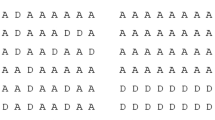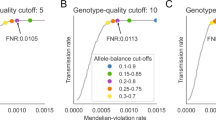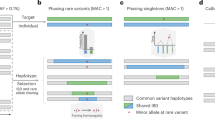Abstract
Yin yang haplotype pairs differ at every SNP. They would not be accounted for by population models that incorporate sequential mutation, with or without recombination. Previous reports have claimed that there is a tendency for common SNPs to form yin yang haplotypes more often than would be expected by sequential mutation or by a random sample of all possible haplotypic arrangements of alleles. In the course of analysing next-generation sequencing data, instances of yin yang haplotypes being formed by very rare variants within a single gene were observed. As an example, this report describes a completely yin yang haplotype formed by eight rare missense variants in the ABCA13 gene. Of 1000 genome subjects, 21 have a copy of the alternate allele at all eight of these positions and a single subject is homozygous for all of them. None of the other 1070 subjects possesses any of the altetrnates. Thus, the eight alternate alleles are always found together and never occur separately. The existence of such yin yang haplotypes has important implications for statistical methods for analysing rare variants. Also, they may be of use for gaining a better understanding of the history of human populations.
Similar content being viewed by others
Introduction
Yin yang haplotypes, in which there is a partial or complete tendency for alleles to be different at every SNP, were first described using markers with a high minor allele frequency (MAF). Using a liberal definition based on haplotypes derived from small numbers of consecutive SNPs it was claimed that such haplotypes were consistent with a neutral evolutionary model incorporating mutation and recombination.1 However, subsequent studies based on longer haplotypes derived from regions of homozygosity using SNPs with MAF >0.05 concluded that common haplotypes were in fact more divergent from each other than would be expected from a random sample of all possible haplotypes.2, 3 As haplotypes formed by processes of mutation and recombination are expected to be more similar to each other than would be a random sample, the observation of these highly divergent haplotypes did not seem to be consistent with such a model. Examples were given of 9-locus haplotypes where the 10 commonest haplotypes in the population included pairs that were completely or almost completely discordant at every SNP. These 9-SNP haplotypes in some cases extended over large genetic distances, the most extreme example being over 14 Mb on the X chromosome, between rs6638361 and rs241393. The mechanism whereby such haplotypes had arisen was unclear but it was proposed that they might represent ancient founder effects and that they might be useful for elucidating population history.
In contrast to these previously described haplotypes of common variants stretching over large genetic distances, the present report describes a similar although more extreme phenomenon occurring with rare coding variants within a single gene. Multiple examples of this phenomenon were observed in the process of developing a novel statistical method that aimed to detect recessive effects by identifying an excess of compound heterozygotes.4 To do this, the method identifies subjects carrying two or more missense variants within the same gene to see whether there is an excess of such subjects among cases. It was noted that sometimes there was a tendency for variants at two or more different positions to tend to occur together in the same subjects. While this might possibly reflect the existence of compound heterozygotes, a likely alternative explanation would be that the variants were in linkage disequilibrium with each other. Obviously, this could occur if a mutation forming the second variant occurred in a haplotype bearing the first. As one would expect little recombination within a gene, such pairs might well then tend to be preserved in the population. What was more surprising was the observation that there sometimes seemed to be a complete co-occurrence of the alternate alleles, such that each was always found with the other and none was observed on its own. A particularly striking example of this was observed in the ABCA13 gene.
Materials and methods
The general method of analysis, which seeks to identify genes exerting recessive effects, is described elsewhere and is implemented as an option in the SCOREASSOC program.4 The method is designed to identify subjects in whom variants may occur together either as homozygotes or as compound heterozygotes. Thus, it begins by identifying all subjects who carry two or more missense, frameshift, splice site and nonsense variants having MAF <0.1. It was applied to the 1000-genome data.5 It quickly became apparent that many variants within genes were in strong LD with each other, in that one variant would tend to occur in the presence of another. More strikingly, it was observed that some variants would form yin yang haplotypes, meaning that pairs of variants occurred together exclusively, that is, either both would be present or neither. Although the phenomenon was observed to a greater or lesser extent in many different genes, for purposes of illustration results are presented here only for the ABCA13 gene.
Results
It was noted that the following missense variants within ABCA13 always occurred together: chr7.hg19.g 48312490G>A, chr7.hg19.g 48313256A>G, chr7.hg19.g 48313563A>G, chr7.hg19.g chr7.hg19.g 48315724C>T, chr7.hg19.g 48315898T>C, chr7.g19.g 48317836G>A, chr7.hg19.g 48318098A>G, chr7.hg19.g 48318400T>G. One subject was homozygous for all the alternate alleles, whereas 21 subjects were heterozygous at all positions. None of the other 1070 subjects carried an alternate allele at any of these positions. Other rare variants appeared to be in LD with this haplotype to a greater or lesser extent. The haplotype always occurred on the background of alternate alleles at chr7.hg19.g 48311602G>A and chr7.hg19.g 48314929T>A. However, four additional subjects were also heterozygous at chr7.hg19.g 48311602G>A and another four subjects were heterozygous at chr7.hg19.g 48314929T>A. Thus, the haplotype would have a D′ of 1 with each of these loci, but they did not exhibit their full yin yang effect because they also sometimes occurred in isolation. The subjects carrying the eight variant alleles are listed in Table 1. It can be seen that they have a wide geographical distribution and that, with the exception of NA19700 and NA19701, they are not known to be related to each other.
Discussion
This brief report does not seek to present a systematic survey of the extent to which yin yang haplotypes occur between rare variants. Such a study would require rigorous definitions and also the ability to derive haplotypes reliably from sequence data. Nor does it attempt to assign an exact P value to the observation reported. The aim is simply to draw attention to the existence of this phenomenon and its implications. The yin yang haplotype reported here has also been observed in exomes sequenced for large case–control association studies currently submitted for publication. It appears to have a similar frequency in all samples studied and there is no suggestion that it has any functional consequence or that the fact that it occurs in ABCA13 is of any special relevance.
It is important to be aware that yin yang haplotypes can occur even among rare missense variants. Any form of LD between variants would invalidate a simple burden test, which assumed that variants occurred independently. As discussed elsewhere, such LD will also invalidate many tests for association that use Monte Carlo methods to permute genotypes rather than haplotypes.6 Likewise, if one tests for an excess of subjects carrying two or more variant alleles, in an attempt to detect compound heterozygotes, it is difficult to distinguish compound heterozygotes from alleles co-occurring through LD. Under a simple coalescent model, one might not expect two very rare variants to occur in a single haplotype and if one observed a single affected subject with two novel variants in the same gene one might suspect that this represented a compound heterozygote disrupting both copies of a gene. However, the existence of yin yang haplotypes implies that one would need to consider the possibility that both variants lay within the same copy of the gene. Another implication is that if certain pairs of variants always occur together then it would never be possible to use population association methods to decide which was causative – one would need to rely on functional studies of artificial constructs in which only one variant was present.
The mechanism whereby such yin yang haplotypes occur is difficult to discern. It is hard to think of plausible biological mechanisms whereby such a rare haplotype might be distributed so widely without any of the constituent variants surviving in isolation. One would need to speculate that either all had arisen simultaneously or they were produced by some form of admixture or bottleneck. However, it is still difficult to visualise exactly what set of circumstances would produce this result. Alternatively, they might arise from some kind of chromosomal rearrangement or sequencing artefact, although again it is not exactly clear what the nature of this might be. It seems that it would be fruitful to study such phenomena further in order to gain a clearer understanding of the mechanisms involved and implications for analytic methodologies.
References
Zhang J, Rowe WL, Clark AG, Buetow KH : Genomewide distribution of high-frequency, completely mismatching SNP haplotype pairs observed to be common across human populations. Am J Hum Genet 2003; 73: 1073–1081.
Curtis D, Vine AE, Knight J : Study of regions of extended homozygosity provides a powerful method to explore haplotype structure of human populations. Ann Hum Genet 2008; 72: 261–278.
Curtis D, Vine AE : Yin yang haplotypes revisited - long, disparate haplotypes observed in European populations in regions of increased homozygosity. Hum Hered 2010; 69: 184–192.
Curtis D : Approaches to the detection of recessive effects using next generation sequencing data from outbred populations. Adv Appl Bioinform Chem 2013; 6: 29–35.
Abecasis GR, Auton A, Brooks LD et al: An integrated map of genetic variation from 1092 human genomes. Nature 2012; 491: 56–65.
He Z, O'Roak BJ, Smith JD et al: Rare-variant extensions of the transmission disequilibrium test: application to autism exome sequence data. Am J Hum Genet 2014; 94: 33–46.
Author information
Authors and Affiliations
Corresponding author
Ethics declarations
Competing interests
The author declares no conflict of interest.
Rights and permissions
About this article
Cite this article
Curtis, D. Rare missense variants within a single gene form yin yang haplotypes. Eur J Hum Genet 24, 139–141 (2016). https://doi.org/10.1038/ejhg.2015.74
Received:
Revised:
Accepted:
Published:
Issue Date:
DOI: https://doi.org/10.1038/ejhg.2015.74
This article is cited by
-
The human genome harbours widespread exclusive yin yang haplotypes
European Journal of Human Genetics (2023)
-
Quinoa genome assembly employing genomic variation for guided scaffolding
Theoretical and Applied Genetics (2021)
-
Intricacies in arrangement of SNP haplotypes suggest “Great Admixture” that created modern humans
BMC Genomics (2017)



